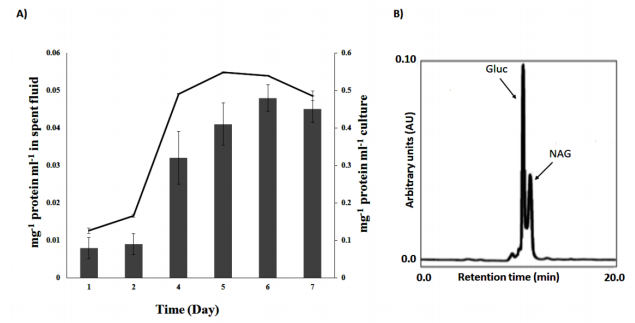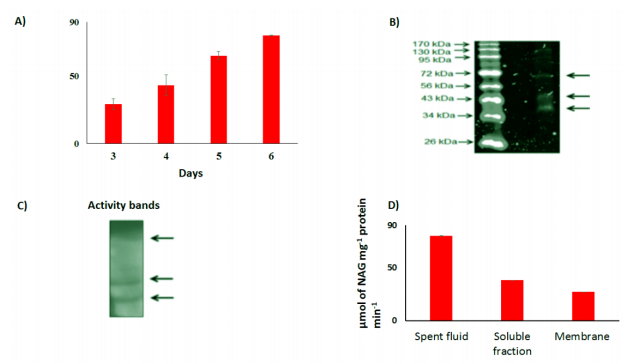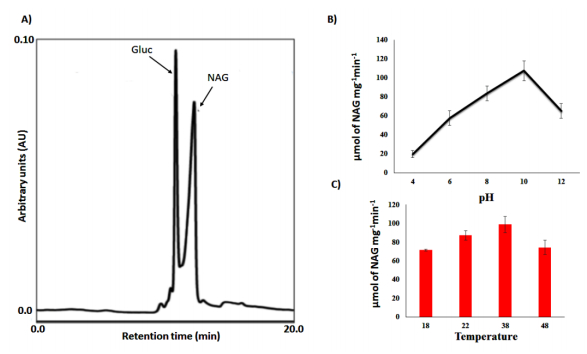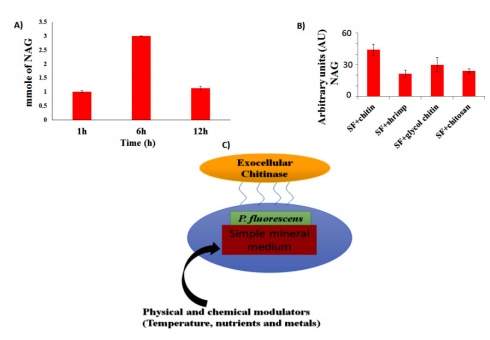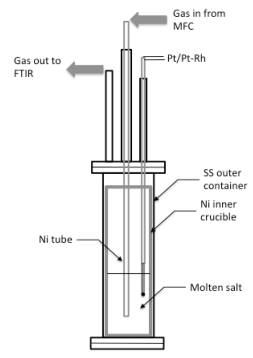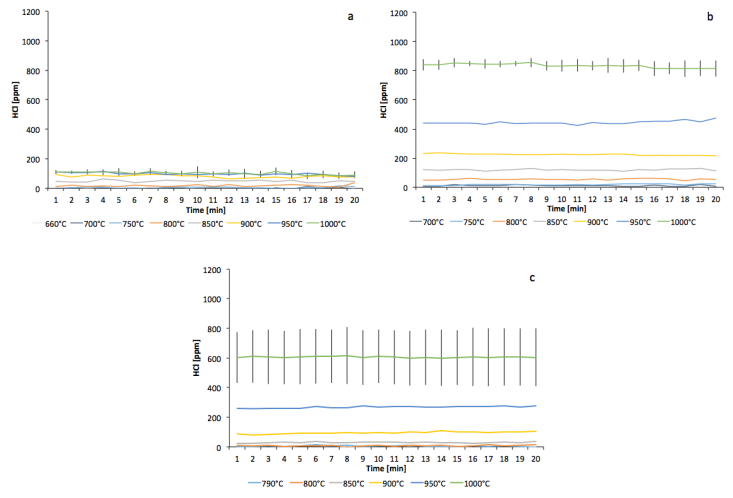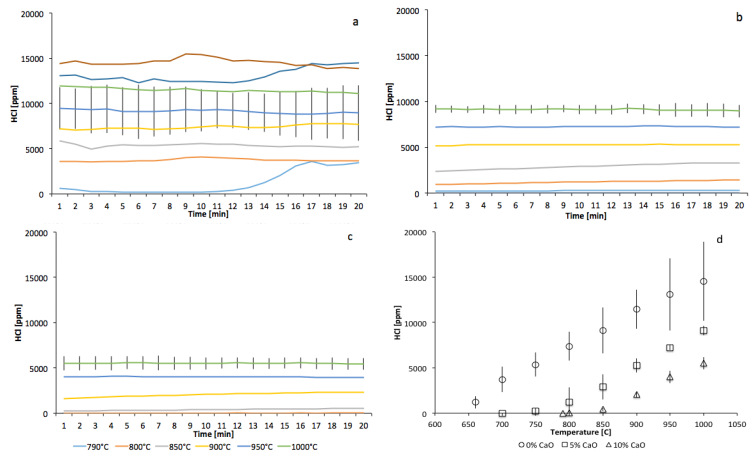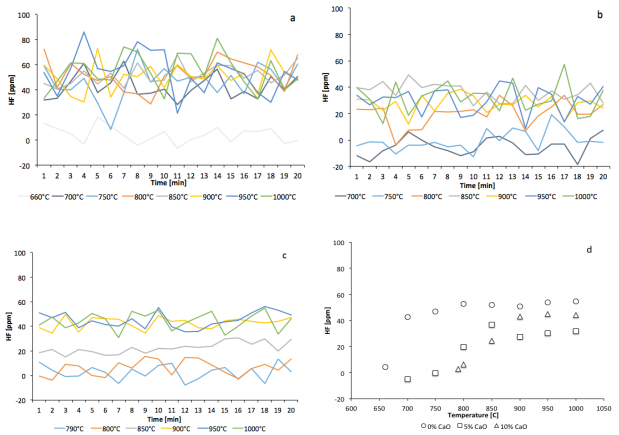1. Introduction
Chitin, the second most widely occurring bio-polymer in nature after cellulose, is composed of β (1→4) linked N-acetylglucosamine (GlcNAc). Unlike cellulose, chitin has an acetamide group and can be a source of carbon and nitrogen. Chitin is a major structural component in the cell walls of fungi and the shells of crustaceans such as lobsters, crabs and shrimp. Worldwide, chitin is an important renewable solid waste generated from the processing of shellfish, krill and shrimps [1] that can be utilized in the production of value-added products. Owing to their biocompatibility, biodegradability, bioactivity, non-toxicity and adsorption properties, chitin and its derivatives [2,3] are used in wastewater treatment, drug delivery, wound healing, and dietary fibre [4].
Hence, the transformation of chitin into commercial products is an ongoing research endeavour. Although chemical solubilisation of the polymer is routinely utilized industrially, it is time consuming, requires harsh conditions such as strong acids and high temperatures and produces waste products [1]. Enzymatic degradation has become a technology of choice in the bioconversion of chitin as it is economical, environmentally-friendly and generates relatively no by-products. Microorganisms are widely utilized for the degradation of polymers and this process has received significant attention in recent years [5,6].
Chitinase (EC 3.2.1.14), that catalyzes the hydrolysis of the β-1-4-glycosidic linkage, is widely distributed in nature and can be found not only in fungi and crustaceans, but is also present in bacteria, viruses, higher plants and humans [7]. Chitinase is known to fulfill numerous physiological roles including the maintenance of cellular morphology, providing nutrients, and promoting infection. It can be obtained from numerous sources and has found applications in medical, agricultural and food industries [8,9,10]. However, its ability to degrade chitin effectively is gaining prominence in biotechnological processes. This enzyme that belongs to the glycoside hydrolase family has the ability to release N-acetyl glucosamine like lysozyme (EC 3.2.1.17) [8].
As part of our study to explore the nutritional versatility of the soil microbe Pseudomonas fluorescens, we have examined its ability to use chitin as the sole source carbon and produce chitinase under various growth conditions [11,12]. This soil microbe is widely used in biotechnological applications and is known not only to produce commercially important metabolites but is also resistant to numerous metal pollutants, an attribute central in the management of metal wastes [12,13,14,15]. Furthermore, its application in the agriculture industry as biofertilizers is well-established [16]. In this report the optimal synthesis of chitinase and its extracellular localization are reported. The significance of these findings in the bioconversion of chitin and shrimp shells into value-added products is discussed.
2. Materials and Methods
2.1. Growth conditions and biomass
The bacterial strain Pseudomonas fluorescens (ATCC 13525), was maintained and grown in 250 mL phosphate mineral medium containing NaHPO4 (1.5 g), KH2PO4 (0.75 g), and MgSO4·7H2O (0.05 g) [17]. Chitin was utilised as the source of carbon and nitrogen in these cultures. In select experiments, NH4Cl (0.2 g) was used as a nitrogen source and/or the medium was supplemented with 50 µM FeCl3. To optimize the yield of microbial biomass and exocellular chitinase production, the amount of chitin was varied from 0.1 g to 2 g. Trace elements were added as described previously [15]. The effect of pH on microbial growth was investigated by varying the pH of culture media from 4–10. The medium was dispensed in an aliquot of 250 mL into 500 mL Erlenmeyer flasks with foam plugs. Inoculations were made with 1 mL stationary phase cells grown in a chitin culture and aerated on a gyratory water bath shaker (Model 76; New Brunswick Scientific) at 26 ℃ and 140 rpm. Cell growth was monitored by measuring bacterial proteins with the aid of the Bradford assay [18]. Ten mL of culture medium was isolated at different growth intervals and following the centrifugation of the bacterial pellet, it was treated with 1 mL of 0.5 M NaOH. The soluble protein content was subsequently measured [19].
2.2. Cellular fractionation and metabolite analyses
Bacteria were harvested at the stationary phase of growth by centrifugation at 10,000 × g and 4 ℃ for 15 min. The spent fluid was collected and the pellets were washed with 0.85% (w/v) NaCl and the pellet was re-suspended in cell storage buffer (CSB; 50 mM Tris-HCl pH 7.6, 5 mM MgCl2, 1 mM dithiothreitol and 1 mM phenylmethylsulphonyl fluoride (PMSF)). To obtain the cell free extract (CFE), the bacteria were lysed via sonication and centrifuged at 180,000 × g for 3 h at 4 ℃, yielding soluble and membrane fractions [15]. The latter was re-suspended in 500 µL of CSB. The protein content in the soluble and membrane fractions was determined using the Bradford assay [18].
Metabolite levels were examined using high performance liquid chromatography (HPLC). The spent fluid and soluble CFE were injected into an Alliance HPLC equipped with a C18 reverse-phase column (Synergi Hydro-RP; 4 μm; 250 × 4.6 mm, Phenomenex) operating at a flow rate of 0.2 mL min–1 at ambient temperature. A mobile phase consisting of 20 mM KH2PO4 (pH 2.9) was used to separate organic acids, which were detected using a Waters dual absorbance detector at 210 nm. Metabolites were identified using known standards, and peaks were quantified with the aid of the Empower software (Waters Corporation). The spent fluid was analysed for metabolites as were chitin, shrimp, glycol chitin and chitosan following incubation with the spent fluid [20].
2.3. Chitinase assay
The spent fluid, soluble CFE and membrane CFE were added with 1 mg chitin. The mixture was incubated at room temperature for 1 h. 100 μL of 0.8 mM sodium tetraborate (Na2B4O7)was added and then boiled for 3 min. Chitinase activity was measured by the amount of NAG produced by adding 3 mL p-dimethylaminobenzaldehyde (DMAB). DMAB was prepared as described [21] and the absorbance at 585 nm was recorded. Chitinase (1 U) is defined as the amount of enzyme which releases 1 μmol of NAG min–1
[22]. D-glucose was assayed using dinitrosalicylic acid (DNS) and was monitored at 540 nm as described [23].
2.4. Polyacrylamide gel electrophoresis and western blot analyses
After the culture was harvested at the stationary phase, the cells were isolated by centrifugation at 10,000 × g for 15 min at 4 ℃. The cell-free supernatant was collected and precipitated by ammonium sulphate (70%) saturation and allowed to stand overnight at 4 ℃. The precipitates were centrifuged, dialysed, and re-suspended with cell storage buffer (50 mMTris-HCl, 1 mM phenylmethylsulfonylfluoride, and 1 mMdithiothreitol pH: 7.6). The molecular mass and activity of chitinase was assessed by SDS-PAGE. The latter was performed as described previously [24,25,26,27] with 0.01% glycol chitin added but devoid of 2-mercaptoethanol. Following electrophoresis, the gel was re-natured by incubation in phosphate buffer (pH 8) with 1% triton X-100 overnight. Upon completion, the glycol chitin containing gel was then stained with 0.01% (w/v) calcofluor white M2R (Sigma) in Tris-HCl buffer (50 mM, pH 7.4 for 30 min). Then, the brightener solution was removed and the gel was washed with distilled water for 1 h at room temperature. The enzyme activity zone was detected by placing the gels on UV-transilluminator and photographed [28,29].
Western blot assays were modified from the Odyssey H Infrared Imaging System protocol document (Li-cor doc# 988-08599). Briefly, the proteins from the SDS gel were electroblotted onto a nitrocellulose membrane using protein transfer buffer (PTS) consisting of (25 mMTris, 192 mMglycine) at 20 V for 16 h. The fixing solution was then removed and the cells were rinsed with TBS (4 g Tris-HCl, 10 g NaCl, pH 7.6 at 4 ℃) containing 0.1% tween-20. The membrane was subsequently incubated in a skim milk blocking buffer for 1 h. Primary antibody (barley chitinase anti-rabbit antibody, a gift from Dr. S. Muthukrishnan, Kansas State University, USA) interactions occurred over a 1 h period with gentle shaking. Primary antibodies were added for 1 h in TBS containing 0.1% Tween-20 and the membrane was washed with TTBS (0.1% Tween-20 with TBS) three times for 10 to 15 minutes each time to remove the unbound antibodies. The membrane was then treated with secondary antibodies diluted to a concentration of 1:1000. Secondary antibodies consisted of goat anti-rabbit (Sigma).
2.5. Physico-chemical and biotechnological studies
In order to define the optimum pH and temperature for chitinase activity, 500 µL of the spent fluid was assayed in various pH ranges from 4–12 and at temperatures ranging from 18–48 ℃ for 1 h. The formation of chitinase was monitored at 585 nm. To determine the stability, the enzyme was monitored at various time intervals over a period of three months. To evaluate the substrate specificity of the enzyme preparation, 500 µL of the spent fluid was incubated for 1 h with 1 mg of substrates such as chitin, shrimp shells, glycol chitin, chitosan, cellulose and starch [30]. NAG was measured by the DMAB assay at 585 nm while the glucose production was monitored by DNS assay at 540 nm. To evaluate the biotechnological potential of this enzymatic preparation, de-proteinated shrimp shells as described [31] (0.1 g) were subjected to 10 mL of spent fluid (0.3 mg protein equivalent) for up to 12 h and NAG production was evaluated.
2.6. Statistical analysis
All experiments were performed in triplicate and in biological duplicate. Data were expressed as mean ± standard deviation (SD).
3. Results and Discussion
In an effort to evaluate the optimal expression of chitinase activity in P. fluorescens ATCC 13525, the microbe was cultured in various nutritional conditions. Chitin was readily utilized both as a source of carbon and nitrogen. At pH 8.3 in the presence of 0.5 g of chitin, the optimal biomass of 0.549 mg protein equivalent per mL of culture was obtained. The inclusion of increased amounts of chitin and NH4Cl did not ameliorate growth rate or cellular yield. Microbial multiplication was negatively influenced at lower pH. At pH 4 there was a 3-fold reduction in biomass while at pH 10 the cellular yield was 30% compared to that recorded during the optimal growth conditions. Addition of FeCl3 was also inhibitory. As the 0.5 g chitin medium at pH 8.3 devoid of ammonium salt afforded the optimal condition, this medium was subsequently utilized to further characterize the degradation of this polymer by Pseudomonas fluorescens (Table 1). Bacterial growth was evident after 2 days and stationary phase of growth was attained within 5–6 days. There was a concomitant increase in protein in the spent fluid (Figure 1A). In effort to elucidate how chitin was degraded the soluble CFE isolated at stationary phase of growth was monitored by HPLC. Peaks that were attributed to NAG and glucosamine were prominent (Figure 1B). Hence, it became evident that chitinase, an enzyme involved in the depolymerisation of chitin into NAG was involved in this process. Various cellular fractions were subsequently probed for chitinase activity. As the spent fluid had the most chitinase activity, the nature of the enzyme was probed in this fraction at various growth periods. At day 6, both the activity and the protein levels were the highest. When chitin was added to the spent fluid, NAG was readily released as confirmed by colorimetric assay and HPLC (Figure 2A).
Table 1. A) Optimization of microbial yield at different concentration of chitin. B) Influence of pH and nutrient on biomass production with 0.5 g chitin.
| A) |
| Chitin concentrations |
Biomass |
| 2 g |
57% |
| 1 g |
95% |
| 0.5 g |
100% |
| 0.1 g |
64% |
| 100% = 0.54 mg protein mL–1, n = 3 ± 1%. |
| B) |
| pH |
Cellular yield |
Nutrients |
Cellular yield |
| 4 |
33% |
NH4Cl |
97% |
| 8 |
100% |
FeCl3 |
55% |
| 10 |
30% |
Phosphate (64 mM) |
100% |
|
|
Phosphate (25 µM) |
65% |
| 100% = 0.549 mg–1 mL–1, n = 3. |
The spent fluid at the stationary phase of growth was isolated and treated with ammonium sulphate ((NH4)2SO4) in order to precipitate the proteins. (Note: No cell lysis was discerned). The pellet was reconstituted and examined for chitinase by gel electrophoresis and Western blotting. Immunoblot studies revealed bands indicative of chitinase (Figure 2B). In an effort to confirm the nature of the isoforms of the enzyme, the proteins were electrophoresed in a SDS gel [25]. Following the re-naturing of the enzymes, three activity bands were obtained, thus pointing to the three isoforms that were being secreted in the exocellular environment (Figure 2C). The spent fluid harboured the most enzymatic activity while the membranous fraction had a specific activity that was the lowest with a value of 27 µmol of NAG mg–1 protein min–1 (Figure 2D). Although the chitinases in the spent fluid did degrade shrimp shell, chitosan and glycol chitin, chitin appeared to be the preferred substrate. NAG was the product generated when the shrimp shells were incubated with the spent fluid (Figure 3A). No discernable amount of D-glucose was released upon the incubation of either cellulose or starch with the exocellular chitinase (data not shown). The enzyme appeared to have an optimal activity in the pH range of 9–10 (Figure 3B). There was a drastic reduction in activity at acidic pH. The chitinase was stable when kept at 4 ℃for 3 months. No significant change of activity was evident when enzymatic preparations were monitored over this period (data not shown). The activity ranged between 70–100% at temperature varying from 18–48 ℃ (Figure 3C).
When de-proteinated shrimp shells were incubated with the spent fluid, NAG was obtained. After a 6 h enzymatic treatment using the P. fluorescens spent fluid, 3 mmole (0.003 g-mol) of NAG was released from 0.1 g of shrimp waste (Figure 4A). While chitin elicited the most chitinase activity, other substrates like chitosan and chitin-glycol were also rapidly broken down into NAG when incubated with the spent fluid (Figure 4B). The foregoing data point to the ability of P. fluorescens to secrete chitinase when chitin is the sole source of carbon and nitrogen. An alkaline pH appears to evoke the maximal bacterial growth and release of extracellular chitinase in mineral medium with no added ammonium salt or cofactors. The enzyme was stable for a period of 3 months and showed maximal activity at pH 10. Recently, an alkaline chitinase with an optimal activity at pH 9.0 and having a molecular mass in the range of 50–125 kDa was reported in Bacillus [30,32]. In this instance, the enzyme was intracellular. Even though in our studies the enzyme was localized in various cellular components, the chitinase in the spent fluid was the most abundant and active. The presence of extracellular chitinases has been reported in P. fluorescens isolated from different plant sources with activities mostly in the range of acidic pH [33]. The physico-chemical properties of the chitinase revealed in this study coupled with its exocellular location makes this enzyme an excellent candidate in the industrial digestion of chitin wastes (Figure 4C). The presence of the enzyme in the spent fluid and its activity in the alkaline pH range make this chitinase more amenable to industrial application compared to those localized intracellularly. Indeed, the efficacy of the spent fluid in generating NAG and glucosamine from shrimp shells may provide interesting biotechnological applications [10].
4. Conclusion
Chitin is an important renewable biomass of immense economic benefit and chitinase provides a controlled route to effectively transform this polymer into value-added products. The discovery of the enhanced production of this enzyme with exceptional attributes by P. fluorescens ATCC 13525 presents a unique opportunity to tailor this microbe and its components for commercial application in the renewable biomass industry. This extracellular chitinase can be readily harnessed as nano-factories designed to convert this renewable biopolymer into chemicals aimed at the agricultural, energy, food and medical sectors.
Acknowledgements
This work is funded by Laurentian University and Northern Ontario Heritage Fund. Azhar Alhasawi is a recipient of funding from the Ministry of Higher Education of Saudi Arabia.
Conflicts of interest
The authors declare that they have no conflict of interest.









 DownLoad:
DownLoad: 